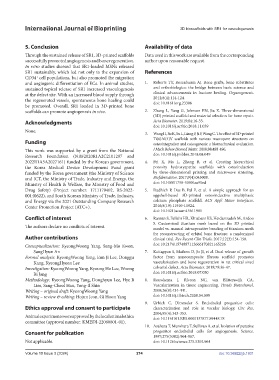Page 282 - IJB-10-3
P. 282
International Journal of Bioprinting 3D bioscaffolds with SR1 for vasculogenesis
5. Conclusion Availability of data
Through the sustained release of SR1, 3D-printed scaffolds Data used in this work are available from the corresponding
successfully promoted angiogenesis and bone regeneration. author upon reasonable request.
In vitro studies showed that SR1-loaded MSNs released
SR1 sustainably, which led not only to the expansion of References
+
CD34 cell populations, but also promoted the migration
and angiogenic differentiation of ECs. In animal studies, 1. Roberts TT, Rosenbaum AJ. Bone grafts, bone substitutes
sustained topical release of SR1 increased vasculogenesis and orthobiologics: the bridge between basic science and
at the defect site. With an increased blood supply through clinical advancements in fracture healing. Organogenesis.
the regenerated vessels, spontaneous bone healing could 2012;8(4):114-124.
doi: 10.4161/org.23306
be promoted. Overall, SR1 loaded in 3D-printed bone
scaffolds can promote angiogenesis in vivo. 2. Zhang L, Yang G, Johnson BN, Jia X. Three-dimensional
(3D) printed scaffold and material selection for bone repair.
Acknowledgments Acta Biomater. 2019;84:16-33.
doi: 10.1016/j.actbio.2018.11.039
None.
3. Wang H, Su K, Su L, Liang P, Ji P, Wang C. The effect of 3D-printed
Ti(6)Al(4)V scaffolds with various macropore structures on
Funding osteointegration and osteogenesis: a biomechanical evaluation.
This work was supported by a grant from the National J Mech Behav Biomed Mater. 2018;88:488-496.
Research Foundation (NRF2020R1A2C2101297 and doi: 10.1016/j.jmbbm.2018.08.049
2022R1A5A2027161) funded by the Korean government, 4. Pei X, Ma L, Zhang B, et al. Creating hierarchical
the Korea Medical Device Development Fund grant porosity hydroxyapatite scaffolds with osteoinduction
funded by the Korea government (the Ministry of Science by three-dimensional printing and microwave sintering.
and ICT, the Ministry of Trade, Industry and Energy, the Biofabrication. 2017;9(4):045008.
Ministry of Health & Welfare, the Ministry of Food and doi: 10.1088/1758-5090/aa90ed
Drug Safety) (Project number: 1711179402, RS-2022- 5. Dadhich P, Das B, Pal P, et al. A simple approach for an
00140622), and South Korean Ministry of Trade, Industry, eggshell-based 3D-printed osteoinductive multiphasic
and Energy via the 2021 Outstanding Company Research calcium phosphate scaffold. ACS Appl Mater Interfaces.
Center Promotion Project (ATC+). 2016;8(19):11910-11924.
doi: 10.1021/acsami.5b11981
Conflict of interest 6. Raisian S, Fallahi HR, Khiabani KS, Heidarizadeh M, Azdoo
S. Customized titanium mesh based on the 3D printed
The authors declare no conflicts of interest. model vs. manual intraoperative bending of titanium mesh
for reconstructing of orbital bone fracture: a randomized
Author contributions clinical trial. Rev Recent Clin Trials. 2017;12(3):154-158.
Conceptualization: KyeongWoong Yang, Sang-Mo Kwon, doi: 10.2174/1574887112666170821165206
SangHyun An 7. Kuttappan S, Mathew D, Jo JI, et al. Dual release of growth
Formal analysis: KyeongWoong Yang, Eun Ji Lee, Donggu factor from nanocomposite fibrous scaffold promotes
Kang, KyeongHyeon Lee vascularisation and bone regeneration in rat critical sized
Investigation: KyeongWoong Yang, Kyoung Ho Lee, Woong calvarial defect. Acta Biomater. 2018;78:36-47.
Bi Jang doi: 10.1016/j.actbio.2018.07.050
Methodology: KyeongWoong Yang, Donghyun Lee, Hye Ji 8. Rouwkema J, Rivron NC, van Blitterswijk CA.
Lim, Sang-Cheol Han, Yong-Il Shin Vascularization in tissue engineering. Trends Biotechonol.
Writing – original draft: KyeongWoong Yang 2008;26(8):434-441.
Writing – review & editing: Hojun Jeon, Gi Hoon Yang doi: 10.1016/j.tibtech.2008.04.009
9. Urbich C, Dimmeler S. Endothelial progenitor cells:
Ethics approval and consent to participate characterization and role in vacular biology. Circ Res.
2004;95(4):343-353.
Animal experiments were approved by the local animal ethics doi: 10.1161/01.RES.0000137877.89448.78
committee (approval number: KMEDI-22080801-01).
10. Asahara T, Murohara T, Sullivan A, et al. Isolation of putative
Consent for publication progenitor endothelial cells for angiogenesis. Science.
1997;275(5302):964-967.
Not applicable. doi: 10.1126/science.275.5302.964
Volume 10 Issue 3 (2024) 274 doi: 10.36922/ijb.1931

